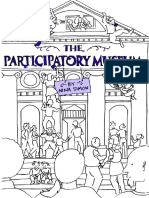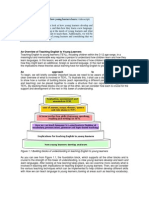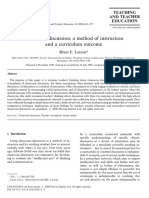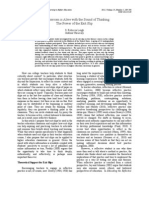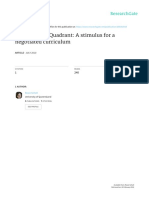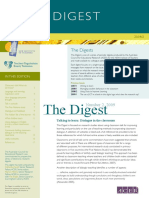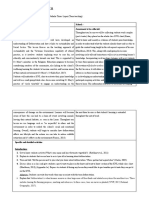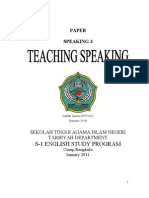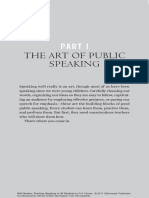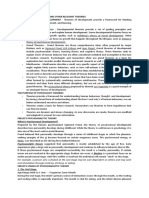Fishbowl Discussions
Fishbowl Discussions
Uploaded by
scottmpetriCopyright:
Available Formats
Fishbowl Discussions
Fishbowl Discussions
Uploaded by
scottmpetriOriginal Description:
Copyright
Available Formats
Share this document
Did you find this document useful?
Is this content inappropriate?
Copyright:
Available Formats
Fishbowl Discussions
Fishbowl Discussions
Uploaded by
scottmpetriCopyright:
Available Formats
Research into Practice Karen D.
Wood, Editor
D. Bruce Taylor
Classroom discussion is so often used as a teaching
strategy in American middle school classrooms (Ewens,
2000) that it is an often taken-for-granted part of the
"grammar of schooling" (Tyack & Tobin, 1994; Tyack &
Cuban, 1995). An integral part of literacy in our society
(Myers, 1996), large- and small-group discussion is
influenced by many factors such as gender (Crowston
& Kammerer, 1998; Godinho & Shrimpton, 2002;
Wolfe, 2000), socioeconomic status (Lubienski, 2000),
and cultural influences including race (Delpit, 1995;
Ladsen-Billings, 2000; Wolfe, 2000). Pedagogic traditions
can unintentionally undermine student engagement.
Marshall (1989) found that in secondary English
classrooms, teachers' primary goal was to engage students
in lively discussions to foster deep analysis of texts, yet the
teachers dominated most literary discussions.
History and tradition notwithstanding, discussion
and questioning can be modeled and taught by teachers
and can foster comprehension (Lloyd, 2004; Alvermann
& Hayes, 1989) and higher-level cognitive skills (Delaney,
1991). Vasquez (2003) used classroom discussion to
promote "critical conversations" that led K-6 students
in her study to create social action projects in their
classrooms.
Discussion formats and strategies exist that can help
both teachers and students create more engaging and
lively discussions across subject areas in middle level
classrooms. The strategies included in this article serve
two primary purposes: (a) scaffolding instructional
techniques for teachers who want to create more lively
and engaged classroom discussions, and (b) providing a
structure to model such discursive practices for students.
Fishbowl discussions
Fishbowl is a way to organize a medium- to large-group
discussion that promotes student engagement and can
be used to model small-group activities and discussions.
Fishbowls have been used by group work specialists and
in counseling (Furr & Barret, 2000; Hensley, 2002),
business (Smart & Featheringham, 2006), and education
(Kong, 2002; Priles, 1993; Slade & Conoley, 1989). Kong
(2002) found fishbowls to be an effective strategy to
foster student engagement in book club discussions.
Research suggests that fishbowls work with students
of diverse abilities. Priles (1993) used the discussion
strategy with large groups of honors students, while
Slade and Conoley's (1989) research focused on special
education students.
Fishbowl takes its name from the way seats are
organized with an inner circle and outer circle. Typically,
there are three or five seats in the inner circle with the
remaining seats or desks forming a larger outer circle.
Not all classroom arrangements allow for the creation of
a distinct inner and outer circle, but seats or tables can
be arranged in a similar pattern with a table or small
group of chairs more or less in the middle of the room
and other students facing this group.
This article reflects the following This We Believe characteristics: Students and teachers engaged in active learning - Curriculum that
is relevant, challenging. integrative, and exploratory -
54
Middle School Journal September 2007
Multiple learning and teaching approaches that respond to student diversity
Fishbowl discussions have multiple purposes.
Fishbowls can be effective teaching tools for modeling
group processes (Hensley, 2002; Priles, 1993), for
engaging students or other groups in discussions of
cross-cultural or challenging topics (Slade & Conoley,
1989), or for giving students greater autonomy in
classroom discussions (Dutt, 1997; Gall & Gillett, 1980).
thoughts and ideas rather than on the teacher's.
Teachers can extend students' participation by allowing
them to generate questions for the discussion. Students
can bring these as "entry tickets" to the discussion
or can work in small groups to generate questions
collaboratively. Fishbowl is a flexible format that can also
be used by teachers to model small-group discussion.
Fishbowl as a student-centered discussion activity
Fishbowl as a tool for modeling discussion
The teacher arranges the room in a fishbowl, with inner
and outer circles of students, and often assigns a text
(section of a textbook or book, a poem, an article, or a
video) to be read or viewed prior to the discussion. The
teacher can generate a set of questions by writing them
on slips of paper or index cards, or students can write
questions or comments on cards. Four or five students sit
in the inner fishbowl and begin a discussion using the
questions; only these students can talk. If a student in
the outer circle wants to say something, he or she must
get up, tap one of the students in the inner circle on the
shoulder, and take his or her place. Whenever a student
is "tapped out" of the fishbowl, he or she takes a seat
in the outer circle and cannot speak unless he or she
returns to the inner fishbowl by tapping another student
out. If students are reluctant to enter the fishbowl, the
teacher can change the rules so that, after a few minutes,
the inner group can tap others into the fishbowl. If
students are too quick to jump into the fishbowl (that
is, they do not give their peers a fair amount of time to
talk before tapping them out), the teacher can set a time
limit of one, two, or three minutes during which students
cannot be tapped out.
Middle school students are social and know how to talk
with one another; however, teachers usually find small
and large-group discussions about subject matter more
challenging to facilitate. Fishbowl can be a vehicle for
modeling and having a meta-discussion about discussion.
As in the example above, the teacher and students
arrange the room with an inner and outer circle. The
teacher selects an appropriate text such as a poem, a
short story, a brief article, or a few pages of a textbook or
book and assigns students to read the selection in class
or for homework. After all students have read the text
on their own, the teacher selects three to five students
for the fishbowl group to discuss the text. They can say
or ask anything they want. The outer circle must remain
quiet but can write down their observations about the
discussion. After several minutes, the inner group
stops, and the outer circle critiques the discussion or
offers suggestions to the fishbowl group. The teacher
can point out strengths of the discussion, offer helpful
comments and questions, and make suggestions for ways
to strengthen the discussion. This is a great way to model
a discussion and talk about what makes for an effective
small-group discussion.
Fishbowl can be a vehicle for modeling and haVing
a meta-discussion about discussion.
This discussion format can be used in any subject
area classroom in which student-centered discussion
is desired. The author has used this format in primary
and secondary English language arts, science, social
studies, and mathematics classrooms on such topics as
global warming, the Holocaust and World War II, and
various novels and shon stories. It has also been effective
in math classes for discussions of problem solving. Used
this way, fishbowl discussions place the focus on students'
Fishbowl discussions can be used to model
discussions of challenging or controversial material in
any subject area. For example, a biology teacher can
use fishbowl at the outset of a unit on Evolution to help
students establish generative and appropriate boundaries
for their discussions about the topic. Similarly, a social
studies teacher can use fishbowl as a way to begin
discussions about issues such as slavery or segregation.
Also, fishbowl is a great way to model literature circle
Research mto PractlCe
55
or book club (Raphael & McMahon, 1994) discussions
in an English language arts class. Fishbowl is a flexible
and powerful tool that can help empower students in
discussions across subject areas. The next strategy, ticket
to talk, can be used in conjunction with fishbowl to
increase student ownership of classroom discussions.
Ticket to talk
Ticket to talk is a discussion strategy involving admission
or exit slips. Students create these slips by writing
anonymous comments or questions about a text or topic
at the end of a class period (an exit slip) or as homework
with an assigned reading (an admission slip to the next
day's class) (Fisher & Frey, 2004; Cere, 1985). Teachers
can use these student-generated questions for whole
class or small-group discussions or as writing prompts.
The value of student-generated questions should not
be underestimated. Their use can increase student
participation and allow teachers greater access to
students' levels of comprehension (O'Keefe, 1995).
Ticket to talk can be an effective tool to generate
questions for fishbowl discussions. Teachers assign a
reading in or out of class and give students a ticket to
talk slip as an admission slip to the fishbowl discussion.
Used this way, the authors have seen lively discussions
generated in a variety of middle level classrooms,
including science, social studies, language arts, health,
and family/consumer science.
Discussion webs
Discussion webs (Alvermann, 1992) encourage students
to engage the text and each other in thoughtful
discussion by creating a framework for students to
explore texts and consider different sides of an issue in
discussion before drawing conclusions (Wood & Taylor,
2005). Discussion webs are an alternative to teacher
dominated discussions to help activate prior knowledge
and make predictions about the text. This activity can
also help students who are not comfortable participating
in large-group discussions talk with a partner or in a
small group.
Discussion webs work well in various content areas.
For instance, discussion web is an excellent format
for considering differing views on global warming in
a science class (Wood & Taylor, 2005). As we see in
Figure 1, discussion web can also be used in an English/
language arts class. The group of sixth grade students
in this class was discussing Bridge to Terebithia (Paterson,
1977) after their literature circle group finished reading
the book. Students in a social studies class could use
discussion web to consider reasons for and against the
U.S. decision to drop atomic bombs on Hiroshima and
Figure 1 Discussion web paired with discussion of Bridge to Terebithia
Question
Should Jess have gone back to
Terebithia after the accident?
Reasons
He wanted to say goodbye to Leslie.
He needed to face his fear.
He was there to save May Belle.
;7
Reasons
It could have been dangerous.
It wasn't the same without Leslie.
He should have gone back when he
found out May Belle followed him.
He saw a sign (a bird) and it
made him feel better.
Conclusions
Yes. Even though it was
dangerous, going back to
Terebithia helped Jess.
56
MiddlE' School Journal September 2007
Nagasaki at the end of World War II or in a math class to
consider alternate ways to solve a multi-step problem.
As with strategies such as fishbowl and ticket to talk,
discussion webs help break the tradition of teacher
centered and controlled discussion and create an
opening for student engagement in conversations that
foster higher-level thinking (O'Keefe, 1995). However,
questions for discussion webs must be crafted carefully so
that they are yes/no questions. Discussion web does not
work with open-ended and nuanced questions but can
create meaningful and lively discussions about substantive
issues that arise in different subject area classrooms.
Motivation is an important aspect of engagement,
which, in turn, is itself an important prerequisite for
learning and a factor in reading achievement and text
comprehension (Guthrie, Wigfield, Metsala, & Cox,
1999). The strategies suggested above, such as fishbowl
and discussion web, are powerful tools for motivating
and engaging students in classroom discussions.
However, there are times when students' struggles with
challenging texts and material are more demanding,
requiring teaching strategies that offer opportunities
for modeling and scaffolding (Combs, 2004) of processes
that promote comprehension, such as say something
and QAR.
Say something
Say something (Short, Harste, & Burke, 1996) is a
metacognitive discussion strategy that provides students
with opportunities to increase comprehension and
monitor their understanding of diverse and challenging
texts. While the strategies suggested so far provide more
open-ended opportunities for students to discuss texts
and topics, say something is a more structured approach
to discussion. Say something provides a set of discussion
prompts for pairs of students to use in a text or topic
centered conversation. These prompts work well with
narrative and expository texts.
Teachers assign students a partner and then
assign a portion of a text that is read either silently or
aloud. Students take turns reading parts of the text
and, in turn, "say something" about what they have just
read. This might involve summarizing the material,
connecting with a character, or asking each other
questions. Partners take turns reading and saying
something until the text selection is complete. The rules
or prompts for say something are these:
Make a prediction.
-
Ask a question.
Figure 2 QAR with a science textbook reading about forest fires
"Right There"
"Think and Search"
"On My Own"
What are three common causes of forest fires?
Why are more homes affected by forest fires
(lightning strikes, volcanic eruptions,
today than 50 or 100 years ago? (Increases
on their own? (students can take a position
and humans)
in population, more homes built near forests,
for or against this)
Should forest fires be allowed to burn
more fire suppression today than in the past)
Research into Practice
57
Clarify something you had misunderstood.
Make a comment.
-
Make a connection.
When a student cannot do one of these five things, he
or she needs to reread the text selection. Say something
is a strategy that helps students who struggle with
comprehension learn to have what Wolfe (1995) calls
a conversation with the text. The range of questions
embedded in say something provides learners with a
metacognitive vocabulary for having that conversation,
which is the hallmark of successful reading and learning.
The final strategy, QAR, also helps scaffold discussions
and foster comprehension but places emphasis on the
kinds of questions we ask of texts.
Question-answer relationships (QAR)
Like its name suggests, question-answer relationships
(Raphael, 1982; Raphael & Au, 2005) is a strategy
that has students examine the relationship between a
question and the kind of information needed to answer
that question. QAR uses three or four categories of
questions, such as (a) "right there" questions that can
be answered directly from the text, (b) "think and
search" questions that require students to combine
their prior knowledge with information from the text
to make inferences, and (c) "in my head" questions that
students answer on their own. These categories cause
students to indicate whether the information they used
to answer questions about the text was textually explicit
information (information that was directly stated in the
text), textually implicit information (information that
was implied in the text), or information entirely from the
student's own background knowledge.
This strategy works well with both fiction and
nonfiction. Teachers and students can create questions
that fall into one of the three categories. It is helpful
for students to read the questions prior to reading the
text and to make predictions about which category each
question fits into. Teachers can model QAR using an
overhead transparency and then transfer responsibility
for using QAR to small groups, pairs, and then
individual students.
Figure 2 provides examples of the three kinds of
questions asked of students during a unit on natural
hazards in a science class. The first question, "What
are three common causes of forest fires?", is an explicit
question that requires students to go to a specific
section of the textbook to answer it. Students must use
information in the text to answer the second question,
"Why are more homes affected by forest fires today than
50 or 100 years ago?", but they must also make inferences
based on their knowledge of population increases over
the last century. Students can take a stand on either side
of the third question, "Should forest fires be allowed
to burn on their own?" Their answer may be informed
by what they have read, but it is essentially an opinion
question.
QAR can help foster a metacognitive conversation
among students about what a question demands of them.
It can provide a vocabulary or set of terms that can
be useful when students struggle to answer a question
during a discussion about a text. The teacher can ask
students to consider what kind of question is being
asked-a text implicit or explicit question. Finally, in an
era of high-stakes accountability testing, QAR is a useful
test-taking strategy for multiple choice test questions that
follow reading passages.
Conclusion
A small group of students learns to apply the question-answer
relationship strategy. P'wto'yAln" Geho
58
Middle School Journal September 2007
Strategies like fishbowl, discussion webs, and ticket to
talk can help middle grades teachers motivate students
to participate in active and comprehensive discussions
Kong, A. (2002, April). Scaffolding in a learning community ofpmctice:
in several content areas. They work with students across
ability levels and give more ownership of classroom
discussion to students. Motivation and engagement are
two key ingredients in fostering comprehension with
diverse learners, but for students who may struggle
with comprehension, we include QAR and say something.
These two strategies provide metacognitive tools
for students and provide teachers a way to model
meaningful discussion.
References
Alvermann, D. E. (1992). The discussion web: A graphic aid for
learning across the curriculum. The Reading Teacher, 45,92-99.
Alvermann, D. E., & Haves, D. A. (1989). Classroom discussion
of content area read'ing assignments: An intervention study.
Reading Research Quarterly, 24, 305-335.
Combs, D. (2004). A framework for scaffolding content area
reading strategies. Middle SchoolJournal, 36(2), 13-20.
Crowston, K., & Kammerer, E. (1998). Communicative style and
gender differences in computer-mediated communications. In
B. Ebo (Ed.), Cyberghetto or cybertopia? Race, class, and gender on
the internet (pp. 185-203). Westport, CT: Praeger.
Delaney, E. (1991). Applying geography in the classroom through
structured discussions. Journal of Geography, 90, 129-133.
Delpit, L. (1995). Other people'S children: Cultural conflict in the
classroom. New York: The New Press.
Dun, K. M. (1997). The fishbowl motivates students to participate.
College Teaching, 45, 143-148.
Ewens, W. (2000). Teaching using discussion. In R. Neff & M.
Weimer (Eds.), Classroom communication: Collected readingsfor
effective discussion and questioning (pp. 21-26). Madison, WI:
Atwood Publishing.
Fisher, D., & Frey, N. (2004). Improving adolescent literacy: Strategies at
work. Upper Saddle River, NJ: Pearson Education.
Furr, S. R., & Barret, B. (2000). Teaching group counseling skills:
Problems and solutions. Counselor Education and Supervision,
40(2),94-104.
Gall, M. D., & Gillett, M. (1980). The discussion method in
classroom teaching. Theory into Practice, 19(2),98-103.
Gere, A. R. (Ed.). (1985). Roots in the sawdust: Writing to learn across
the diSCIplines. Urbana, lL: National Council of Teachers of
English.
Godinho, S., & Shrimp ton, B. (2002, December). Exploring
differences in students' engagement in literature discussions. Paper
presented at the Annual Meeting of the Australian Association
for Research in Education, Brisbane, Australia.
Guthrie,]. T, Wigfield, A., Metsala,]. L., & Cox, K. E. (1999).
Motivational and cognitive predictors of text comprehension
and reading amount. Scientific Studies ofReading, 3, 231-256.
Hensley, L. G. (2002). Teaching group process and leadership: The
two-way fishbowl model. .Journalfor Specialists in Group Work, 27,
273-286.
:l. case study of a gradual release of responsibility from the teacher to
the students. Paper presented at the Annual Meeting of the
International Reading Association, San Francisco.
Ladsen-Billings, G. (2000). Fighting for our lives. Journal of Teacher
Education, 51(3), 206-214.
Lloyd, S. L. (2004). Using comprehension strategies as a
springboard for student talk. Journal of/ldolescent and Adult
Literacy, 49(2), 114-124.
Lubienski, S. T. (2000). A clash of social class cultures'
Students' experiences in a discussion-intensive seventh-grade
mathematics classroom. The Elementary SchoolJournal, 100,
377-403.
Marshall,]. D. (1989). Patterns of discourse in classroom discussions of
literature. Albany, NY: SUNY Albany, Center for the Learning
and Teaching of Literature.
Myers, M. (1996). Changing our minds: Negotiating English and literacy.
Urbana, IL: National Council of Teachers of English.
O'Keefe, V. (1995). Speaking to think/thinking to speak: The importance
of talk in the learning process. Portsmouth, NH: Boynton/Cook
Publishers.
Paterson, K. (1977). Bridge to Terabithia. New York: Thomas Y.
Crowell.
Priles, M. A. (1993). The fishbowl discussion: A strategy for large
honors classes. TheEnglishJournal, 82(6), 49-50.
Raphael, T E. (1982). Question-answering strategies for children.
Reading Teacher, 36, 186-191.
Raphael, T E., & Au, K. H. (2005). QAR: Enhancing
comprehension and test taking across grades and content areas.
The Reading Teacher, 59, 206-22\.
Raphael, T E., & McMahon, S. (1994). Book club: An alternative
framework for reading instruction. Reading Teacher, 48, 102-116.
Short, K. G., Harste,]., & Burke, C. (1996). Creatingclassroomsfor
authors and inquirers (2nd ed.). Portsmouth, NH: Heinemann.
Slade,]. C., & Conoley, C. W. (1989). Multicultural experiences for
special educators. Teaching Exceptional Chzldren, 22(1),60-64.
Smart, K. L., & Featheringham, R. (2006). Developing effective
interpersonal communication and discussion skills. Business
Communication Quarterly, 69(3),276-283.
Tyack, D., & Cuban, L. (1995). Tinkering toward utopia. Cambridge,
MA: Harvard University Press.
Tyack, D., & Tobin, W. (1994). The "grammar" of schooling: Why
has it been so hard to change? American Educational Research
Journal, 31, 453-479.
Vasquez, V. (2003). Getting beyond "!like the book": Creating space
for cnticalliteracy in K-6 classrooms. Newark, DE: International
Reading Association.
Wolfe,]. (2000). Gender, ethnicity, and classroom discourse:
Communication patterns of Hispanic and White students in
networked classrooms. Written Communication, 17,491-519.
Wolfe, D. P. (1995). Reading reconsidered: Literature and literacy In high
school. New York: The College Board.
Wood, K. D., & Taylor, D. B. (2005). Literacy strategies acroSs the
subject areas (2nd ed.). New York: Allyn & Bacon.
Karen D. Wood is a professor of reading education and graduate reading program coordinator at the University of North Carolina at Charlotte.
E-mail: kdwood@emall.uncc.edu
D. Bruce Taylor is an assistant professor of reading and elementary education at the University of North Carolina at Charlotte.
E-mail: dbtaylor@uncc.edu
Research into Practice
59
You might also like
- Edu 512 Tompkins Chapter 1-12 NotesDocument12 pagesEdu 512 Tompkins Chapter 1-12 Notesapi-438371615100% (2)
- Llama Llama Red Pajama - Lesson PlanDocument6 pagesLlama Llama Red Pajama - Lesson Planapi-242586984100% (1)
- Eald Booklet Assignment 2Document18 pagesEald Booklet Assignment 2api-359191228100% (3)
- Components in Designing Integrated Thematic Units 060804Document8 pagesComponents in Designing Integrated Thematic Units 060804Junriv Rivera100% (1)
- Fifty Ways to Teach Reading: Fifty Ways to Teach: Tips for ESL/EFL TeachersFrom EverandFifty Ways to Teach Reading: Fifty Ways to Teach: Tips for ESL/EFL TeachersRating: 4 out of 5 stars4/5 (3)
- What Caused The Dust Bowl?: OverviewDocument12 pagesWhat Caused The Dust Bowl?: OverviewscottmpetriNo ratings yet
- NINA SIMON Participatory MuseumDocument390 pagesNINA SIMON Participatory Museumanaliamariel75% (4)
- Edla430 Assignment 3 - Unit of WorkDocument35 pagesEdla430 Assignment 3 - Unit of Workapi-319193686No ratings yet
- Case Study About Classroom DiscourseDocument10 pagesCase Study About Classroom DiscourseVille Hendi100% (1)
- Annie Hughes Talking About How Young Learners LearnDocument20 pagesAnnie Hughes Talking About How Young Learners LearnMaria Isabel La PuenteNo ratings yet
- MODULE 9 VygotskyDocument4 pagesMODULE 9 VygotskyTricia Morga83% (12)
- Classroom Discussion: A Method of Instruction and A Curriculum OutcomeDocument17 pagesClassroom Discussion: A Method of Instruction and A Curriculum OutcomeWeniarti DarmawansyahNo ratings yet
- Midnight's Children LPA #1Document10 pagesMidnight's Children LPA #1midnightschildren403No ratings yet
- Classroom DiscourseDocument14 pagesClassroom DiscourseQushoy Al IhsaniyNo ratings yet
- Academic Conversations Classroom Talk That Fosters Critical Thinking and Content Understandings by Crawford, MarieZwiers, JeffDocument280 pagesAcademic Conversations Classroom Talk That Fosters Critical Thinking and Content Understandings by Crawford, MarieZwiers, Jeffwacwic wydadNo ratings yet
- 3.12.BercawLiterature Discussions and Classroom InteractionsDocument16 pages3.12.BercawLiterature Discussions and Classroom InteractionsТеодора ВласеваNo ratings yet
- Classroom DiscourseDocument3 pagesClassroom Discoursechahinez bouguerraNo ratings yet
- Talking To Learn Across Classrooms and Communities: Spencer Salas, Paul G. Fitchett, and Leonardo MercadoDocument8 pagesTalking To Learn Across Classrooms and Communities: Spencer Salas, Paul G. Fitchett, and Leonardo MercadoDelia CristeaNo ratings yet
- Speaking N Listening BackgroundDocument8 pagesSpeaking N Listening Backgroundtree3cool100% (1)
- Exit Slip JournalDocument8 pagesExit Slip JournalDwi Artawan Gold KnightNo ratings yet
- CHAPTER II (09-12-2020) Recount TextDocument20 pagesCHAPTER II (09-12-2020) Recount Textjihadoelz falahNo ratings yet
- How To Make Unv Classes More InteractiveDocument6 pagesHow To Make Unv Classes More InteractiveCupertino CastroNo ratings yet
- Unit 2 LacDocument8 pagesUnit 2 LacAthira I PNo ratings yet
- Dialogic TeachingDocument13 pagesDialogic TeachingM.A Silmi MahrudinNo ratings yet
- 06RE062 Effective Classroom Talk in ScienceDocument10 pages06RE062 Effective Classroom Talk in ScienceMartin MateusNo ratings yet
- Academic ConversationsDocument7 pagesAcademic ConversationsdrkwelshNo ratings yet
- Reading PhilosphiesDocument5 pagesReading PhilosphiesSusana KomodaNo ratings yet
- Crookes Critical PedagogyDocument10 pagesCrookes Critical PedagogyCarlos VillamizarNo ratings yet
- BROWN - What Kind of TextDocument17 pagesBROWN - What Kind of TextNerakNo ratings yet
- Effective Clasroom DiscussionDocument5 pagesEffective Clasroom Discussionsoliloquium47No ratings yet
- Rosie Scholl - Question QuadrantDocument15 pagesRosie Scholl - Question Quadrantapi-308496539100% (1)
- Wilkinson 2009 OneDocument12 pagesWilkinson 2009 Onemandyndawana71No ratings yet
- Bucket Filler Lesson PlanDocument4 pagesBucket Filler Lesson Planapi-302347003No ratings yet
- (Let's Talk About It - Strategies For Integrating Writing and Speaking in The Classroom) Etf - 58 - 4 - pg22-31Document10 pages(Let's Talk About It - Strategies For Integrating Writing and Speaking in The Classroom) Etf - 58 - 4 - pg22-31Paolo ColabresNo ratings yet
- Beehive - Eng Textbook (NCERT)Document121 pagesBeehive - Eng Textbook (NCERT)Gitanjali NayakNo ratings yet
- 8 ClassroomdiscouseDocument11 pages8 ClassroomdiscouseSisma rellyNo ratings yet
- The Dynamics of Using Argumentation in The EFL ClassroomDocument5 pagesThe Dynamics of Using Argumentation in The EFL Classroomwaqarali78692No ratings yet
- Combining Dictogloss and Cooperative Learning To Promote Language LearningDocument15 pagesCombining Dictogloss and Cooperative Learning To Promote Language LearningEmily James100% (1)
- TITLE: Exploring The Term Dialogue' in Freire's Pedagogy of The Oppressed' in Connection To Curriculum Design and ImplementationDocument6 pagesTITLE: Exploring The Term Dialogue' in Freire's Pedagogy of The Oppressed' in Connection To Curriculum Design and ImplementationKateNo ratings yet
- CombiningDocument6 pagesCombiningMega Fariziah N. HumairohNo ratings yet
- 1078 3233 1 PB PDFDocument4 pages1078 3233 1 PB PDFVille HendiNo ratings yet
- Lesson Plan RioDocument4 pagesLesson Plan RiosulatkamayNo ratings yet
- Talking To Learn - Dialogue in The Classroom PDFDocument17 pagesTalking To Learn - Dialogue in The Classroom PDFVibha100% (1)
- Functional Analysis of Children's Classroom Talk: A Framework For Understanding Children's Discourse in Educational ContextsDocument12 pagesFunctional Analysis of Children's Classroom Talk: A Framework For Understanding Children's Discourse in Educational ContextskambuaNo ratings yet
- Classroom TalkDocument6 pagesClassroom Talkapi-308102782No ratings yet
- Domain C Article - Strategies For ElsDocument5 pagesDomain C Article - Strategies For Elsapi-278255765No ratings yet
- Study On The Teaching Method in General With Special Reference To Discussion Method of TeachingDocument20 pagesStudy On The Teaching Method in General With Special Reference To Discussion Method of TeachingDirector KjaNo ratings yet
- Engaging Learners: Conversation-Or Dialogic-Driven Pedagogy?Document22 pagesEngaging Learners: Conversation-Or Dialogic-Driven Pedagogy?daguiani mohamedNo ratings yet
- Literature Circles As Support For Language Development PDFDocument9 pagesLiterature Circles As Support For Language Development PDFJairo TurriateNo ratings yet
- Rose (2002) A - Class-Centred - Approach - To - Language - Teaching PDFDocument8 pagesRose (2002) A - Class-Centred - Approach - To - Language - Teaching PDFChompNo ratings yet
- The Language Experience Approach and Adult LearnersDocument5 pagesThe Language Experience Approach and Adult LearnersLahandz MejelaNo ratings yet
- Edst Assignment OneDocument5 pagesEdst Assignment Oneapi-357170723No ratings yet
- Exploring The Concept of Students As Active Participants in Teacher-Child Dialogue in A New Zealand ContextDocument11 pagesExploring The Concept of Students As Active Participants in Teacher-Child Dialogue in A New Zealand ContextniaNo ratings yet
- Assignment 2 (8601) - Muhammad Farhan - 0000237611 - Spring22Document27 pagesAssignment 2 (8601) - Muhammad Farhan - 0000237611 - Spring22Malik Farhan AwanNo ratings yet
- Dialogue Agreeing and DisagreeingDocument10 pagesDialogue Agreeing and DisagreeingJoseph Ambrose Edwards0% (1)
- Additional RRLDocument11 pagesAdditional RRLmae ann CadenasNo ratings yet
- ED423550 1998-00-00 Problem-Based Learning in Language Instruction: A Constructivist Model. Eric DigestDocument6 pagesED423550 1998-00-00 Problem-Based Learning in Language Instruction: A Constructivist Model. Eric DigestAndrea Lovato100% (3)
- Critical Pedagogy in Language TeachingDocument10 pagesCritical Pedagogy in Language TeachingAngie LopezNo ratings yet
- CLIL AssignmentDocument7 pagesCLIL AssignmentAlbertoNo ratings yet
- Lesson 6 Literature SarahDocument20 pagesLesson 6 Literature Sarahs200310sarahNo ratings yet
- Module 10 Consolidated Final Working 10.9.2019Document9 pagesModule 10 Consolidated Final Working 10.9.2019partha3273No ratings yet
- Ed 409746Document6 pagesEd 409746Yến TrầnNo ratings yet
- LITERATURE BASED INSTRUCTION For English LearnersDocument7 pagesLITERATURE BASED INSTRUCTION For English Learnersheningayu arsariNo ratings yet
- Chapter 3 Teaching in A Multi Grade ClassroomDocument62 pagesChapter 3 Teaching in A Multi Grade ClassroomandenextenderNo ratings yet
- Edla430 Assignment 3 Terina MacareDocument26 pagesEdla430 Assignment 3 Terina Macareapi-266593657No ratings yet
- Teaching SpeakingDocument9 pagesTeaching SpeakingBoe Amelia Nz100% (2)
- Esson: Understanding CurriculumDocument11 pagesEsson: Understanding CurriculumGretchen Arcaño FlorentinoNo ratings yet
- Tell Me With ESLDocument3 pagesTell Me With ESLAlAmeyczdbfciiNo ratings yet
- Special Interest: Empathy Mapping in Social StudiesDocument7 pagesSpecial Interest: Empathy Mapping in Social StudiesscottmpetriNo ratings yet
- The Harlem HellfightersDocument7 pagesThe Harlem HellfightersscottmpetriNo ratings yet
- Social Studies Simulations - BrownDocument36 pagesSocial Studies Simulations - BrownscottmpetriNo ratings yet
- Syrian Refugee CrisisDocument8 pagesSyrian Refugee CrisisscottmpetriNo ratings yet
- Lusitania Children's BookDocument31 pagesLusitania Children's BookscottmpetriNo ratings yet
- Pages From WellspokenDocument15 pagesPages From WellspokenscottmpetriNo ratings yet
- Ferrara Rosen DeviceDeliveredAutomaticallyScored IAEADocument12 pagesFerrara Rosen DeviceDeliveredAutomaticallyScored IAEAscottmpetriNo ratings yet
- Discussion LeadingDocument6 pagesDiscussion LeadinghoopsmcsteelNo ratings yet
- SocraticSmackdown v1Document23 pagesSocraticSmackdown v1scottmpetri100% (2)
- DBQs - As Formative Assessments PDFDocument14 pagesDBQs - As Formative Assessments PDFscottmpetriNo ratings yet
- Soc Sci Disc Concepts & ToolsDocument6 pagesSoc Sci Disc Concepts & ToolsscottmpetriNo ratings yet
- DBQs - As Formative Assessments PDFDocument14 pagesDBQs - As Formative Assessments PDFscottmpetriNo ratings yet
- Hist Assmnts of Thinking Breakstone-SummaryDocument23 pagesHist Assmnts of Thinking Breakstone-Summaryscottmpetri100% (1)
- Lac Understanding ResponsesDocument20 pagesLac Understanding ResponsesSheila Jane Dela Pena-LasalaNo ratings yet
- Iusd Homework and RememberingDocument9 pagesIusd Homework and Rememberingbjgmbuhjf100% (1)
- Cody Hartsburg Lesson Plan 2 Learning TaxonomiesDocument3 pagesCody Hartsburg Lesson Plan 2 Learning Taxonomiesapi-697356179No ratings yet
- CSTP 3 Cardenas 12Document7 pagesCSTP 3 Cardenas 12api-431761955No ratings yet
- Curriculum Map in Science 10 4th QuarterDocument13 pagesCurriculum Map in Science 10 4th QuarterLegend DaryNo ratings yet
- Book Review "The TKT Course Clil Module"Document8 pagesBook Review "The TKT Course Clil Module"Alexander DeckerNo ratings yet
- LibraryDocument7 pagesLibraryfareehaNo ratings yet
- Inclusive Education Assignment 2 1Document27 pagesInclusive Education Assignment 2 1api-417829366No ratings yet
- Curriculum AdaptationsDocument23 pagesCurriculum Adaptationsavinash boodhooNo ratings yet
- Eng 3081Document78 pagesEng 3081Jessica AngelinaNo ratings yet
- Ejemplo de PD CompletoDocument30 pagesEjemplo de PD CompletoAndrea Núñez ArizaNo ratings yet
- Shute (2008) Enfoque en La Retroalimentación FormativaDocument38 pagesShute (2008) Enfoque en La Retroalimentación FormativaKarollNo ratings yet
- Venn Diagram 1Document1 pageVenn Diagram 1api-257758992No ratings yet
- S9 - APADV - Handout9.3 - Template For Learning Plan - With Calendar INSETDocument7 pagesS9 - APADV - Handout9.3 - Template For Learning Plan - With Calendar INSETKaren Jamito MadridejosNo ratings yet
- Decoding LearningDocument89 pagesDecoding LearningNesta100% (1)
- UntitledDocument3 pagesUntitledEthan NealNo ratings yet
- Asci Lesson PlansDocument27 pagesAsci Lesson Plansapi-707473847No ratings yet
- Examining the Impact of Differentiated Instructions on Students learning at primary level in one of the private schools of Karach1 (2)Document21 pagesExamining the Impact of Differentiated Instructions on Students learning at primary level in one of the private schools of Karach1 (2)aaqif.raeesNo ratings yet
- Developmental Theories and Other Relevant TheoriesDocument11 pagesDevelopmental Theories and Other Relevant TheoriesMary Ann Mendez75% (4)
- 1 Explicit Instruction 1 Per PG RDocument40 pages1 Explicit Instruction 1 Per PG RdirectoraltNo ratings yet
- Salma Begum Research Proposal Final DraftDocument8 pagesSalma Begum Research Proposal Final Draftinayatkhattak890No ratings yet
- Captivating Conversations EVAAS Tutorial: Kirstin Morrison ECI 514 Fall 2015Document16 pagesCaptivating Conversations EVAAS Tutorial: Kirstin Morrison ECI 514 Fall 2015api-318001037No ratings yet
- Amber Warren Teaching EFL For Young LearnersDocument41 pagesAmber Warren Teaching EFL For Young LearnersDina Bensureiti100% (1)






